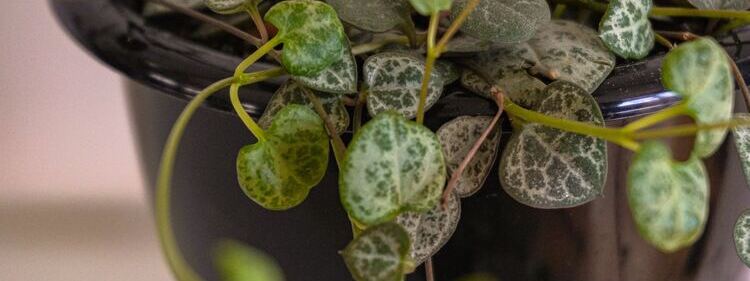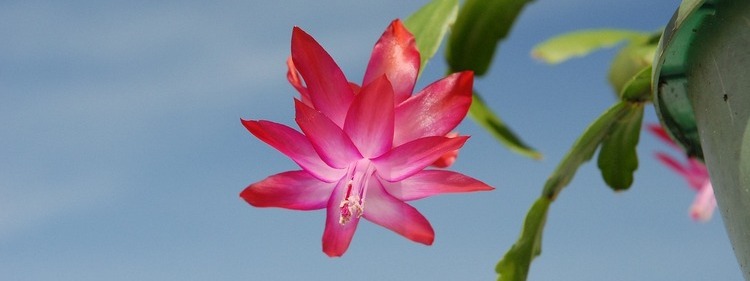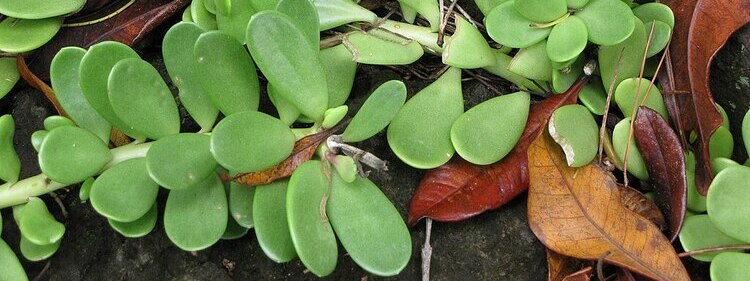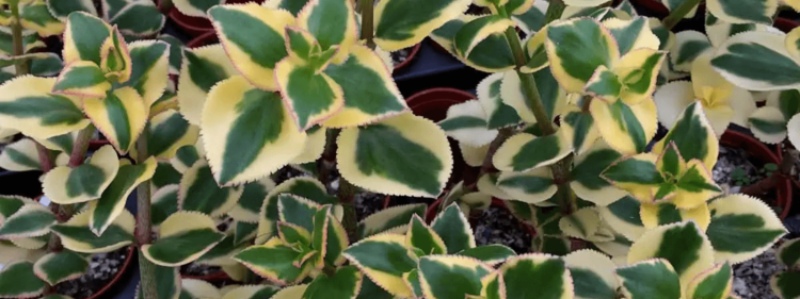You can easily brighten your home by decorating it with hanging succulents. It is no wonder why 42% of the respondents of a study across the United States took up gardening as a hobby during the height of the pandemic. Meanwhile, Australians spent $2.6 billion on plants in 2021.
If you’re a beginner plant parent, you might want to opt for hanging succulents. What’s great about these types of plants is that they are easy to care for and they can cope being indoors or outdoors.
The trick is to choose the right types of hanging succulents that can survive under the shade or without constant airflow. Thankfully, there are lots of plants that can do just that.
In this article, we’re going to share the best hanging succulents that you can use to decorate your home. Whether you’re a beginner or an experienced gardener, you’ll surely find the ideal succulent from our list.
What Are Hanging Succulents?
Succulent plants have thick, fleshy tissues that are adapted for storing moisture. Because of their ability to tolerate drought, they make good, low-maintenance houseplants.
Many succulent plants have trailing stems that fall to the sides of their pots. Some of the most popular types of succulents with trailing stems include the string of dolphins, string of pearls, and Christmas cactus.
What Are the Best Types of Hanging Succulents?
You’d be surprised to discover that you can choose from more types of hanging succulents. Here are some of your options:
1. Burro’s Tail
Scientific name: Sedum morganianum
If you prefer a hanging succulent plant that can easily turn into a conversation piece, you should consider getting a burro’s tail. This trailing succulent has thick stems or ‘tails’ with tightly packed leaves, making it look like a donkey’s tail. Moreover, its leaves come in a striking green colour, making it an ideal décor for hanging baskets.
This plant has fragile, long stems that can reach almost two feet in length. So, you should hang this plant away from traffic and in an area that’s unreachable for pets and children.
Burro’s tails are native to Mexico where the conditions are typically warm. However, they can still grow and thrive in cooler areas.
Make sure you use well-draining soil and hang the plant in an area that gets plenty of sunshine. Also, you should water the soil only when you notice it becoming dry. During the growing season, the plant will need feeding once or twice a year.
2. Calico Kitten
Scientific name: Crassula pellucida variegata
What you’ll love about the calico kitten succulent plant is its heart-shaped, variegated leaves. The different shades of pink, green, cream, and purple are a feast for the eyes. You’ll easily adore calico kitten leaves once you see them in person.
The plant even looks better in hanging baskets because of the way the stems trail over the rims. The stunning leaves fill the container before growing overflowingly.
With adequate sun exposure, this succulent’s leaves turn purple and even produce white flowers. This plant will thrive in well-draining soil. Also, when the temperature drops, it’s best to keep your calico kitten indoors.
Make sure you water the plant only when the soil is dry to touch. In spring and summer, don’t forget to add a bit of fertiliser to encourage growth. If you want to get more tips about caring for your calico kitten, look for the best plant care apps online.
3. Chain of Hearts
Scientific name: Ceropegia woodii
Also known as string of hearts, the chain of hearts is a rosary vine with thin stems that have heart-shaped leaves. Depending on the conditions and the pot size, their strings can grow a couple of metres in length.
Make sure you hang your chain of hearts in a bright spot that gets adequate airflow. Even so, this is one of the types of hanging succulents that can survive in darker or shaded areas of the house. However, if you want yours to look nicer and healthier, you should expose your chain of hearts under the best growing conditions.
Make sure you use a free-draining mix with low nitrogen or a succulent potting mix when planting your string of hearts. Also, don’t forget to use pots with a drainage hole. However, if you purchased the wrong pot and you’re not fond of cutting holes, then be careful with how you water the plant.
When it’s warm, water the plant once a week. In the colder months, increase the frequency to two times a week. Don’t worry too much if you accidentally overwater the plant. It will survive as long as it is not soaked in stagnant water.
4. Christmas Cactus
Image by Vikki Lambert Kimbrough from Pixabay
Scientific name: Schlumbergera buckleyi
The Christmas cactus has other common names like the Thanksgiving cactus and holiday cactus. This succulent plant usually blooms during October, November or December. You’ll notice its hanging, arched branches that have segmented and flat pads.
Because the Christmas cactus is an epiphytic succulent, it thrives under filtered or indirect light. It is also a short-day plant. So, if you want to trigger flowering, make sure that the succulent gets 8 hours of light and 16 hours of darkness. Make sure that you hang your Christmas cactus indoors, where it won’t get exposed to sunlight throughout the day.
5. Cliff Cotyledon
Scientific name: Schlumbergera buckleyi
The Christmas cactus has other common names like the Thanksgiving cactus and holiday cactus. This succulent plant usually blooms during October, November or December. You’ll notice its hanging, arched branches that have segmented and flat pads.
Because the Christmas cactus is an epiphytic succulent, it thrives under filtered or indirect light. It is also a short-day plant. So, if you want to trigger flowering, make sure that the succulent gets 8 hours of light and 16 hours of darkness. Make sure that you hang your Christmas cactus indoors, where it won’t get exposed to sunlight throughout the day.
5. Cliff Cotyledon

Scientific name: Cotyledon pendens
If you love the beautiful, red anthuriums, you’ll also appreciate the cliff cotyledon succulent. Also known as little cliff bells, this stunning succulent has egg-shaped and fuzzy leaves. You’ll usually see them in greyish-green colour, but they also have reddish edges.
What’s interesting about this plant is its red and pink bell-shaped flowers. They gracefully hang down from the ends of the Cotyledon pendens’ stems.
On the ground, this plant creates small shrubs with drooping stems. However, when you plant it in a hanging basket, it gorgeously flows down, accented by beautiful bell-shaped blooms.
The cliff cotyledon plant is closely related to the bear’s paw succulent. When you cultivate it, make sure that you expose it to the sun throughout the day. Even so, it will still survive indoors or in a partially shaded area. Just make sure that your cliff cotyledon is still in a bright environment.
Use the bottom watering method on this plant. Also, keep your cliff cotyledon out of reach of children and pets, as the plant can be toxic when ingested.
6. Coral Cactus
Scientific name: Rhipsalis cereuscula
Also known as the rice cactus, the coral cactus has segmented stems that look like corals. This succulent plant is native to Brazil, usually growing under filtered light and large trees.
So, exposing the plant to too much sunlight will burn its stems. On the other hand, when the temperature drops, coral cactus stems turn red.
When planting your coral cactus, you’ll need rich soil. Moreover, you need to follow a strict fertilising and watering routine. You wouldn’t want waterlogged soil for this hanging succulent plant. So, improve the drainage and let the soil dry between watering.
If you want to trigger blooms, you should place your coral cactus in the dark for a prolonged period. You can hang this succulent plant to avoid exposing it to rising temperatures. Once it starts blooming, you’ll enjoy beautiful flowers in a range of colours, including purple, white, and pink.
7. Dancing Bones

Scientific name: Hatiora salicornioides
The dancing bones succulent has another interesting name—the drunkard’s dream. This plant’s jointed stems initially grow upwards. Eventually, they drunkenly trail over the rims of hanging pots and baskets. At the same time, this plant got its name “dancing bones” because of its segmented stems that look like bone joints.
The dancing bones are succulent plants that originated from the rainforests of Brazil. So, they’d need similar conditions to thrive. When spring comes, you’ll see stunning yellow flowers growing out of the tips of their stems. However, don’t be surprised if they seem dormant in the winter. They eventually go back to life once the temperature rises.
Make sure you let the soil dry in between watering to ensure that it’ll survive. In spring, don’t forget to occasionally give the plant a boost of liquid fertiliser. If you’re planting outdoors, place your dancing bones in a bright area that does not get direct sunlight.
8. Elephant Bush
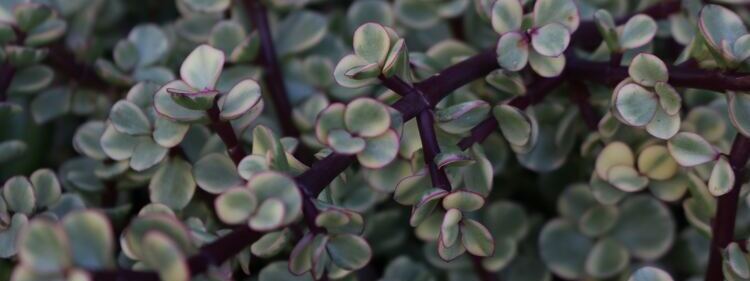
Scientific name: Portulacaria afra
The elephant bush is widely popular among homeowners because of its ability to clean the air. According to research, this plant can efficiently absorb carbon from the environment. So, aside from being a decorative plant, the elephant bush can be a great air purifier for your home.
This plant is native to South Africa where the conditions can be humid, wet, or dry. Its red, arching stems cascade over hanging pots and baskets. Moreover, they are beautifully adorned with stunning green leaves.
This succulent plant got its common name because elephants in South Africa love to eat it. You can also eat it and add it to your salad if you want a crunchy texture and a sour taste to your greens.
However, most homeowners cultivate it as a bonsai or as a hedge. Of course, you can also plant it in hanging baskets.
Make sure you plant your elephant bush in well-draining soil and hang it in a location that gets plenty of sunlight. It can also thrive in a partially shaded area. You’ll love its mauve to pink flowers that usually bloom after the rain.
9. Fishbone Cactus
Scientific name: Disocactus anguliger (formerly classified as Epiphyllum anguliger)
The fishbone cactus is one of the hanging succulents with leafless, flattened stems. Its stems have a jagged appearance that make them look like zippers. As such, it has other nicknames like “rickrack cactus” or “zigzag cactus”.
This succulent plant usually grows in the jungle, and it’s distinguishable for its showy and large flowers. Usually coming in yellow and white colours, its flowers look a bit like oriental lilies.
The stems initially grow upright. However, as they grow longer, they start bowing down, making them perfect for hanging pots or baskets. Moreover, they can reach up to several feet long. So, they will look great as they trail down.
Make sure you don’t hang your fishbone cactus in an area that gets direct sunlight. Otherwise, the leaves might get sunburnt. The good thing is that this succulent plant is considered non-toxic. When properly cared for, it may even produce an edible fruit that’s similar to the dragon fruit or pitaya.
10. Hens and Chicks
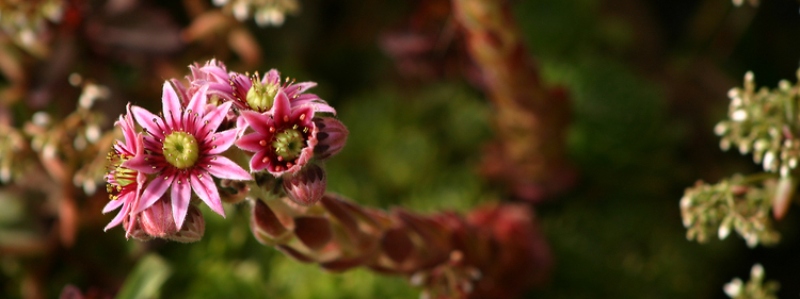
Sempervivum tectorum. (2023, February 5). In Wikipedia.
Scientific name: Sempervivum tectorum
You can refer to any member of the Crassulaceae family as hens and chicks. However, the most popular variety is the one classified as Sempervivum tectorum, or more widely known as the common houseleek.
The hens and chicks succulent has beautiful rosettes with greenish-grey or pale green leaves. The tips are often reddish purple.
While this plant produces rosettes that make great ground cover, it is still perfect for hanging baskets. With proper care, this succulent will eventually grow flower stalks with reddish-purple blooms.
There’s also an interesting reason why the common name of this plant is hens and chicks. The central rosette is like a hen that produces smaller offsets or “chicks”. The offsets will create a trailing effect once they start spilling over the edges of your hanging basket.
Make sure that your hens and chicks will get plenty of sunlight. Even so, you can hang them indoors as long as you place them in a brightly lit spot. Moreover, the plant is non-toxic, making it safe for pets and children.
The common houseleek has also received an Award of Garden Merit from the Royal Horticultural Society. So, you can expect that the process for cultivating it is simple and easy.
11. Hindu Rope

https://commons.wikimedia.org/wiki/File:Hoya_compacta_18.JPG
Scientific name: Hoya carnosa compacta
What makes the Hindu rope interesting is its trailing ropes of vines accented by clusters of tiny, pink flowers. This epiphytic vine has twisting leaves that will stunningly adorn your hanging basket.
Do note that the furry, double-star flowers take some time to appear. It may even take a couple of years before they bloom. However, they are truly worth the wait.
When cultivating the Hindu rope, you’ll need a good orchid mix. Moreover, you have to hang the plant in a spot that gets at least six hours of sunlight. Once you’ve chosen a good location, leave the Hindu rope there. After all, the plant doesn’t like being moved around.
Also, you shouldn’t overwater the plant. Its waxy leaves can store enough water to keep it healthy for a while. Fertilising once or twice a year would suffice.
12. Ice Plant
Scientific name: Corpuscularia lehmannii
Many succulent plants use the common name “ice plant.” However, most of these are often grown as garden perennials or annuals instead of houseplants.
The ice plant that we’re discussing here is one that you won’t find in regular flower beds. A member of the fig marigold or Aizoaceae family, this succulent plant has wedge-shaped, chunk leaves with a bluish-grey to green colour. The ice plant also produces yellow flowers that look like starflowers.
When you cultivate the ice plant, expect its succulent stems to sprawl and spread outside your hanging pot or basket. Even so, you’ll love the ethereal appeal that its chunky stems give off.
It’s easy to care for the ice plant, especially since it grows quickly. Make sure that it gets plenty of sun exposure throughout the day to keep it healthy. Like other members of the fig marigold family, the ice plant is non-toxic.
13. Jade Necklace
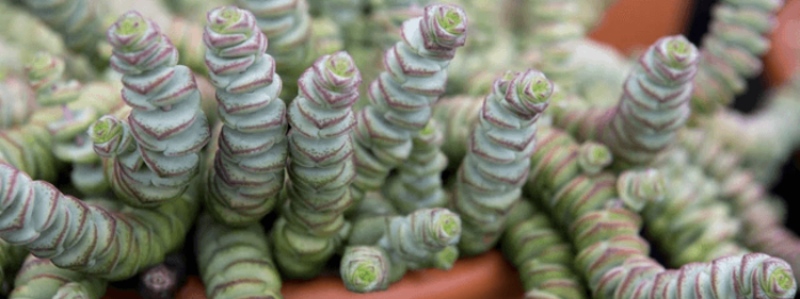
Photo by Gardener’s World:
Scientific name: Crassula rupestris subsp. marnieriana
Because the leaves of the jade necklace are tightly packed together, the plant’s trailing stems look like strands of gemstones. Also referred to as the Chinese pagoda, this subspecies of Crassula rupestris have squarish, light-green leaves with red edges. It resembles the native gum stems we use as accents for our Sweet Petite bunch.
When exposed to the sun, the edges turn purple. This succulent plant also produces cream and pink flowers.
The jade necklace’s stems can grow as long as a foot, allowing them to trail beautifully out of a hanging pot or basket. As these stems cascade, they eventually rise up which gives them a snake-like appearance. So, it’s not surprising why the plant is also referred to as the “worm plant”.
It’s easy to care for the jade necklace. When you hang it indoors, make sure it is in a brightly lit spot. It should also get a few hours of direct sunlight.
On the other hand, if you’re hanging your jade necklace on your porch or around your garden, choose a partially shaded area. Too much direct sunlight may burn the leaves. Moreover, you should keep the plant away from the reach of pets and children as it is potentially toxic.
14. Jelly Bean Plant

Photo by Alexphotos:
Scientific name: Sedum x rubrotinctum
As its name suggests, the jelly bean plant has green, glossy leaves that look like cute jelly beans. Its stems cascade down, then eventually turn upright. Excessive exposure to the sun turns the small, bean-shaped leaves of this plant to red or pink.
The jelly bean plant also goes by other names like “pork and beans” and “Christmas cheer.” The clusters of leaves trail nicely over a hanging pot’s edges. Moreover, with proper care, this plant will produce star-shaped, yellow flowers.
This succulent needs bright, indirect light to thrive. During the colder months, make sure you bring your jelly bean plant indoors. While this sedum species is non-toxic, it can still cause skin irritation. So, wear gardening gloves when handling it.
15. Lantern Flower
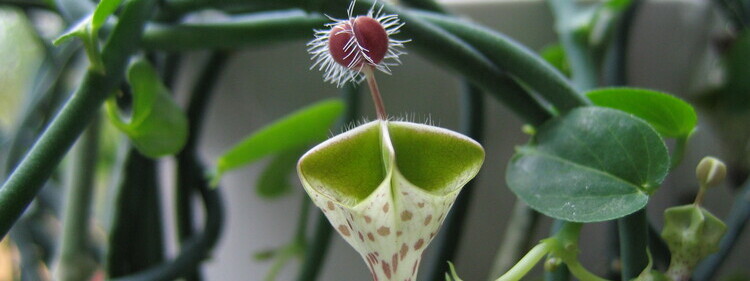
From Wikimedia Commons:
Scientific name: Ceropegia haygarthii
A member of the Apocynaceae family, the lantern flower has trailing, fleshy stems with a bluish-green colour. Its stems also have a climbing growth habit, and they can reach several feet long. So, this succulent plant is a great option for hanging pots and baskets.
Another interesting feature of this succulent is its flowers. They look like cream or white lanterns with burgundy speckles. The furry ball that grows out of the flower’s centre makes it seem like this plant came from a different planet.
The lantern flower has many other names, including “parasol flower,” “wine-glass vine,” “snake creeper,” and “bushman’s pope.” This plant may look ethereal and unusual, but it is incredibly easy to care for. You can hang it indoors—just make sure it is in a brightly lit spot. Also, use well-draining, rich soil to create the right growing environment for the plant.
The lantern flower is one of the types of hanging succulents that need regular watering. You shouldn’t let the soil completely dry out in between watering. During the colder season, it becomes dry and dormant. So, don’t assume that it died.
16. Meezo Trailing Red
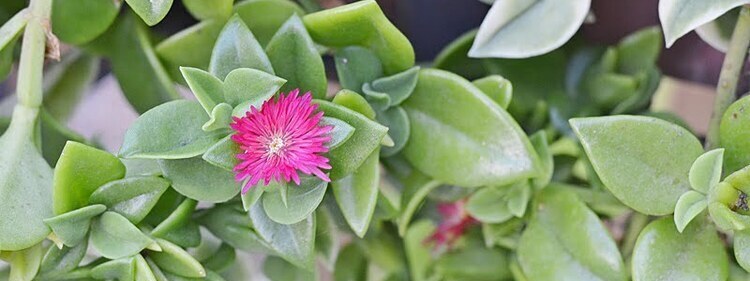
Photo by Cottage at the Crossroads:
Scientific name: Dorotheanthus-bellidiformis
People usually cultivate the meezo trailing red for its beautiful tiny blooms that resemble beautiful gerberas. Its succulent leaves are green and trimmed with white edges. While this plant makes great ground cover, it also has a trailing growth habit. In pots, its stems can grow as long as eight inches.
The meezo trailing red prefers sunlight, but it will still survive in a partially shaded area. In places with snow, the meezo trailing red is cultivated as an indoor plant.
Because its leaves effectively store water, it can tolerate drought quite well. However, when it gets warmer, make sure to water more frequently. While its flowers bloom in the summer, its variegated foliage makes it a great decorative plant throughout the year.
17. Medusa’s Head

Photo by Leonora (Ellie) Enking:
Scientific name: Euphorbia caput-medusae
If you want to add an eerie feel to your garden, then you’ll appreciate the beauty of Medusa’s head. As you would expect, this succulent plant is reminiscent of the well-known character in Greek mythology. Its central ‘head’ grows stems that look like crawling snakes.
The succulent stems of Medusa’s head can reach over two feet long. They even have bluish-green, scale-like feature that makes them even more interesting. Even so, you’d be surprised to see the ends of these stems growing small, yellow flowers.
Also known as the jellyfish head euphorbia and green crown, Medusa’s head thrives when exposed to the sun. However, it can also survive indoors if placed in a brightly lit area. You should know that you could get contact dermatitis from the sap coming from Medusa’s head. So, handle the plant with gloves and keep it out of reach of pets and children.
18. Million Hearts
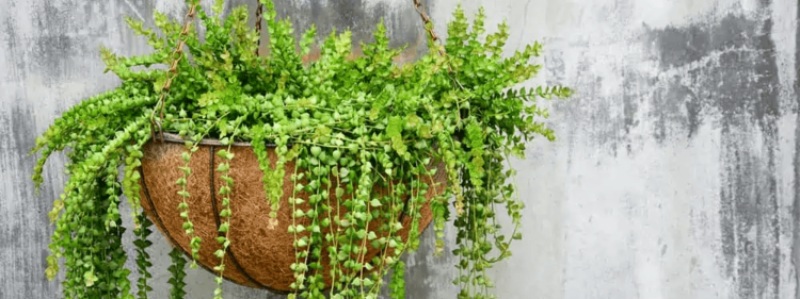
Photo by Garden Pals:
Scientific name: Dischidia ruscifolia
There are many reasons to adore the million hearts succulent. For one, it has small, heart-shaped leaves. As cliché as it sounds, these leaves come in pairs, growing opposite each other. Besides, the countless heart leaves may serve as reminders that love can be found everywhere.
Its stems can trail as long as three feet, producing small white flowers towards the end of spring and the beginning of summer. However, too much exposure to the light will cause it to become leggy. The scorching sun will also damage the leaves and turn them from green to red.
Native in Asian countries like the Philippines, the million hearts naturally grows at the top of trees. While this succulent plant loves moisture and humidity, it doesn’t like being waterlogged. So, make sure you use well-draining soil to set the right conditions for the plant.
It’s quite easy to cultivate the million hearts. When you’re hanging this plant indoors, place it in a bright spot that gets indirect light. Now, if you’re using it to decorate your patio or porch, the trailing succulent should be in a partially shaded location.
In between watering, allow the soil to dry. Even so, this succulent plant prefers higher humidity. So, it is best to use an orchid mix that will retain adequate moisture for your million hearts. Also, the plant can be toxic when ingested. As such, you should keep your million hearts away from the reach of children and pets.
19. Mistletoe Cactus
Scientific name: Rhipsalis baccifera
Since they come from the same Rhipsalis genus, the mistletoe cactus and coral cactus share similar features. They both have segmented stems, but the difference is the latter can grow longer.
The mistletoe cactus is one of the types of hanging succulents that has a strong visual impact. Because of its long, trailing stems, this plant is perfect for elevated pots and hanging baskets.
However, like the coral cactus, the mistletoe cactus does not like long exposure to direct sunlight. Better plant it in a free-draining or succulent potting mix. Moreover, you should only water the plant when the soil is dry to touch.
In general, the mistletoe cactus can survive in the same pot for several years. Now, if you choose to transfer the plant to a bigger container, its stems will grow longer.
20. Monkey’s Tail
Scientific name: Hildewintera colademononis
When monkey’s tails mature, white, fine hairs cover their long, fleshy, and thick stems. These stems look like tails that cascade over the edge of a hanging basket. When they’re fully grown, they can reach up to eight feet long.
Monkey’s tails initially grow upright with scattered white spines. However, as they become longer and heavier, they start to curve and trail down. In the spring and summer seasons, monkey’s tails produce stunning, reddish flowers.
You should wait until the soil is completely dry before you water this plant. During the colder months, don’t water the plant and keep it indoors to protect it from frost. This succulent will grow best when it is in a brightly lit spot that doesn’t get direct sunlight.
21. October Daphne

From Wikimedia Commons:
Scientific name: Sedum sieboldii
October daphne succulents have upright stems with flesh, rounded leaves. As they grow longer, the stems spill over the edge of their container. Depending on the growing environment and the changing seasons, the plant’s leaves may change colours. At times, they can be blue-green, but they can also come in shades of red and pink.
Towards the beginning of the autumn season, the October daphne produces clusters of star-shaped, pink flowers. It’s not uncommon for its stems to reach around ten inches long.
Usually, this plant is cultivated in the garden as a ground cover. However, they can look great in hanging pots, especially since the stems have a trailing growth habit.
When growing the October daphne, make sure you use well-draining soil with good compost. You should also choose a location that gets plenty of sunlight. While this succulent can tolerate drought, it needs extra watering during the warmer months. To encourage more blooms, don’t forget to deadhead the flowers.
22. Peanut Cactus

Scientific name: Echinopsis chamaecereus
The peanut cactus is another hardy, trailing succulent plant that is perfect as a home décor. While its stems do not grow too long, they look quite attractive especially since they resemble peanuts.
At first glance, peanut cacti may have spiny stems. However, the bristles on this hanging succulent are quite soft to touch. You’ll also appreciate the red and orange flowers that this plant produces. Its blooms have several pointy petals that come out from their funnel-shaped bases.
Compared to the previous succulent plants, this mountain cactus requires careful attention. Under hot, dry conditions, this plant will need occasional watering and lots of bright light. Moreover, peanut cacti tend to struggle in high humidity. Instead, it prefers its natural habitat’s dry air. With enough care, this plant will begin to produce beautiful blooms in spring.
23. Pencil Cactus
Scientific name: Euphorbia tirucalli
Just like the Medusa’s head, the pencil cactus is a member of the Euphorbia family. With its thin and branching stems, it creates a wispy, delicate foliage mass in your hanging pot or basket.
This succulent plant also goes by other common names like “pencil euphorbia,” “Indian tree spurge,” “African milk bush,” finger tree,” and “firestick plant.” It’s perfect for Nordic houses and minimalist architectural styles, especially with its inconspicuous yellow flowers.
It's quite easy to care for the pencil cactus. If you’re hanging this plant indoors, make sure you place it in a bright spot that gets indirect sunlight. Now, if you’re placing it outdoors, find a partially shaded area.
The pencil cactus is better cultivated in a pot. If you cultivate it in the ground, it quickly spreads and becomes an invasive species. You should also wear gloves when handling this succulent because its milk sap can irritate your skin.
24. Queen of the Night

Photo by Public Domain Pictures:
Scientific name: Epiphyllum oxypetalum
If you’ve seen the romantic comedy movie, Crazy Rich Asians, then you’re probably familiar with the queen of the night. This succulent orchid plant has long, spineless stems. However, what makes it special is its stunning flowers that bloom only once a year. Moreover, the buds only open atnight and wilt before dawn.
A member of the Cactaceae family, the queen of the night doesn’t have true leaves. Instead, it has green stems that are articulated and flat. You’ll also notice that its stems have wavy margins or a slightly scalloped feature.
The succulent stems initially grow upright. However, as they grow longer, they begin to sprawl—even reaching up to ten feet long. The nocturnal flowers of this succulent orchid usually come in white, gold, or pink.
Growing as a lithophyte or epiphyte, the queen of the night also goes by other common names. Some of its nicknames include “princess of the night,” “night-blooming cereus,” and “Dutchman’s pipe cactus. If you cultivate yours in a hanging basket, your queen of the night will easily become a conversation piece. It’s perfect for anyone who loves white, elegant flowers.
If you’re caring for the queen of the night indoors, hang it in a brightly lit area. It can also tolerate direct sunlight, but it prefers shade when the temperatures rise. This succulent orchid is also safe for households with young children and pets. After all, it is generally considered non-toxic.
25. Rat Tail Cactus

Photo by ossisso:
Scientific name: Aporocactus flagelliformis (formerly Disocactus flagelliformis)
The rat tail cactus is another trailing succulent plant with slender, pale green stems. What makes this plant interesting is the bristle-like spines on its stems. Moreover, rat tail cacti can produce showy, big, and bright flowers.
You can hang the plant in areas that get lots of sunlight, but it will also thrive under partial shade. So, it can survive as an indoor hanging plant. Just note that its stems can grow several metres in length.
While the rat tail cactus has spines, they are not too sharp. Even so, you should still wear gloves when handling this succulent plant just to be safe.
Use a free-draining or succulent potting mix when planting rat tail cacti. They’re among the types of hanging succulents that do not require frequent maintenance. So, you don’t have to worry about regular watering. If you’re caring for the plant indoors, you can hang it by the window where it can get plenty of sunlight and adequate airflow.
26. Ruby Necklace
Scientific name: Othonna capensis
While the ruby necklace is a succulent ground cover, its stems trail over hanging baskets and pots. It grows narrow, cylindrical leaves that changes colours from green to burgundy and purple.
What’s impressive about this plant is it grows yellow flowers that look like daisies year-round. So, it can be a lovely addition to the hanging plants on your patio or porch.
The ruby necklace is a desert succulent. So, it prefers dry conditions. However, during the summer season, you need to protect it from the harsh sunlight. Place it in a partially shaded area when the conditions become too hot.
27. Silver Dollar Vine

Photo by Wikimedia Commons:
Scientific name: Xerosicyos danguyi
The thick stems of the silver dollar vine produce large, fleshy, and round leaves. Its stems trail down and spill over the edges of a hanging basket. However, it can also climb stakes or trellises. As its name suggests, its leaves look like a dollar coin. While the leaves of the silver dollar vine succulent are what makes it interesting, it also produces beautiful yellow flowers in the early spring.
The silver dollar vine is tolerant to drought. So, you don’t need to water it frequently—just enough to prevent the leaves from wrinkling. Also, it grows best when placed in a partially shaded area withindirect sunlight.
You can use any type of soil as long as it has good drainage. Moreover, don’t forget to fertilise once a year to encourage healthy growth.
28. Starfish Flower
Photo by Wikimedia Commons:
Scientific name: Orbea variegata (formerly classified as Stapelia variegate)
The starfish flower is a succulent plant with a rotting scent. What’s the most impressive about this plant is its five-petaled flowers. Its blooms may be striking and attractive, but their smell is so unpleasant that they usually attract like flies and insects.
The starfish flower may look like a carnivorous succulent plant, but surprisingly, it is not. Despite that, it remains interesting. Its cactus-like stems cascades over the rims of hanging pots and baskets.
This pungent succulent plant is native to South Africa. So, it thrives in sunny conditions. You can also hang it indoors but place it in a warm spot.
Also, don’t forget to take your starfish flower outside once it blooms in the summer. You wouldn’t want your home to smell like rotting flesh! This plant smells nothing like our Spring Scents Hat Box bunch!
29. String of Bananas
Scientific name: Senecio radicans
The string of bananas is quite similar to the string of pearls, only the latter is more sun-tolerant and hardy. What makes this succulent interesting is its banana-like leaves. Moreover, with proper care, this plant can produce beautiful white flowers several times a year.
You can encourage growth and blooms by hanging your string of bananas in a bright spot. The plant also needs proper ventilation, especially when the conditions are humid.
The string of bananas’ leaves turn red with prolonged exposure to the sun. Meanwhile, its flowers have a tubular base, and they look like bursts of fluffy, little balls on the long stems.
If you plan on cultivating this hanging succulent, make sure to use well-draining soil. In addition, the soil should be kept consistently moist. However, the plant is highly susceptible to root rot. So, you must follow a careful watering schedule.
When kept outdoors, the plant should be in a partially shaded area. However, when hung indoors, it should be in a brightly lit location.
While the string of bananas originated from South Africa, it can still thrive in regular household temperatures. As long as you keep the plant away from extreme heat and cold drafts, it will survive. You can also upgrade your pots regularly to encourage growth.
30. String of Buttons
Scientific name: Crassula perforata
If you prefer the types of hanging succulents that are easy to grow, you should consider cultivating the string of buttons. It has thin stems with triangular leaves forming on opposite sides in a spiralling pattern. The stems somehow look like the fried tornado potatoes you find in fairs.
String of button stems initially grow upright, but they begin trailing over the rims of hanging baskets as they grow longer. Their thick strands can reach up to about two feet long.
What’s great about this succulent is that it can survive indoors even if the area you choose is not brightly lit. On the other hand, if you give it enough sun exposure, its leaves will eventually develop touches of pink.
Make sure you use cactus mix or sandy soil when cultivating the string of button. If you’re a beginner, you’d have no trouble caring for this plant because it is incredibly low maintenance. It will continue to survive even if you neglect it for some time.
However, don’t expose it to the cold. If the temperature drops, bring it indoors to ensure that it’ll survive.
31. String of Dolphins

Photo by The Horticult:
Scientific name: Bacurio delphinatifolius (formerly classified as Dendrophorbium peregrinum)
The string of dolphins look similar to the string of bananas. However, the former has leaves that look like dolphins leaping out of the water. This succulent plant can grow as tall as six inches while its trailing stems can reach up to a foot long.
This succulent plant is an intergeneric hybrid with light-green leaves and flowers that look like white pom-poms. Previously classified as Dendrophorbium peregrinum, the string of dolphins is a combination of the string of pearls and the candle plant.
It’s easy to manage the vines of the string of dolphins, especially if you place it in a small, hanging basket. However, make sure you cultivate it in an area that gets plenty of sunlight. It’s also potentially toxic which means that it should be kept away from the reach of kids and pets.
32. String of Nickels
Scientific name: Dischidia nummularia
Also referred to as the button orchid, the string of nickels is a beautiful trailing succulent plant with dark-green leaves. When cultivated properly in the right conditions, its stems can trail as long as three feet.
The string of nickels has stems that produce oval-shaped leaves. It got its name from its leaves that resemble coins. So, it’s not uncommon to see this plant with the name “string of coins” when you shop online.
This plant is considered an epiphyte which means that you’ll need a well-draining potting mix. You can also use an orchid mix to give it the ideal conditions for growing. Under the right environment, your string of nickels will bloom white or yellow flowers in spring and summer.
When hanging your string of nickels, place it in a bright spot that gets indirect sunlight. Its leaves are delicate which means exposing it to direct sunlight may burn it. You can water the plant once every two weeks or when the soil becomes dry to touch.
While the string of nickels does not like the sun, it doesn’t thrive under cold conditions. So, if you’re hanging the plant around your porch or patio, make sure it has some protection when it gets cold.
33. String of Pearls
Scientific name: Senecio rowleyanus
The string of pearls is loved by many for its small, spherical, and water-storing leaves. Once you see it up close, you’d be interested in cultivating it. However, if you’re planning to hang it indoors, you must know that the process can be challenging.
After all, it can be difficult to keep this succulent plant alive when it doesn’t get plenty of airflow and sunshine. So, if you want better chances of survival, better place it by a bright window.
This trailing succulent vine originated in southwest Africa where the conditions are usually dry. Even so, they usually sprout under the shade of rocks and other plants. Too much exposure will burn the string of pearls’ leaves.
Also, when you’re growing this plant, you need the right pot size. If you use an inappropriately large container, the soil will never dry in between watering. Consequently, any beads touching the soil may begin to rot. Moreover, the string of pearls has shallow roots. So, ideally, you should get a smaller pot. If you want longer strings, you can upgrade to a slightly bigger pot each year.
34. String of Tears
Photo by Wikimedia Commons:
Scientific name: Curio herreanus (formerly classified as Senecio herreianus)
The string of tears is one of the many hanging succulents that originated from South Africa. Also known as the “string of raindrops” and the “string of watermelons,” this plant has teardrop-shaped leaves.
While its globules generally have a light-green colour, some also have stripes. So, in some cases, they may look like tiny watermelons.
Hang your string of tears in a partially shaded area. Otherwise, exposing it to too much sunlight may darken its purple stripes. In the right conditions, the thin, upright stems may produce white daisies. Also, note that the whole plant can grow as long as a foot.
As we’ve mentioned, you can encourage healthy growth by placing your string of tears in a brightly lit area, away from direct sunlight. Even so, the area shouldn’t be too dark. Otherwise, the stems will start stretching excessively.
Also, this is one of the types of succulents that need well-draining soil. While it can tolerate drought, it will grow best when watered regularly. Make sure you keep it away from children and pets because it is potentially toxic when ingested.
35. String of Turtles
Scientific name: Peperomia prostrata
While the string of turtles is among the most popular hanging succulents, it is quite unpredictable. So, don’t make the mistake of treating this plant like other common ‘string’ succulent plants. Moreover, the string of turtles tends to die easily under colder conditions.
This hanging succulent plant prefer regulated temperature. So, it’s best that you keep it indoors in a shaded area. Also, choose a spot that is not too hot or too cold.
36. Trailing Jade
Photo by Wikimedia Commons:
Scientific name: Senecio jacobsenii
Also referred to as the “vining jade” or “weeping jade,” the trailing jade is a creeping succulent with thick stems. It is great as ground cover, but its stems can dramatically cascade over any hanging basket or pot.
While its scientific name is Senecio Jacobsenii, trailing jades are also known as Kleinia Petrea. You’ll love the bright orange flowers that this hanging succulent plant produces during fall and winter.
The edges of its leaves even turn reddish maroon, making it more stunning during the autumn season. Their hues of red can be as dark as the ficus ruby plant. Besides, this succulent is striking enough with its hanging stems and leaves that can grow up to four feet in length.
Whether you hang your trailing jade under partial shade or in full sun, you can expect it to thrive. Hanging succulent plants are widely known to love warmth. However, trailing jades can survive through the frost. They can tolerate temperatures as low as -6 degrees Celsius.
However, remember that trailing jades struggle when the conditions are too humid or moist. So, strategically hang the plant in the ideal location. Also, don’t worry about frequent watering. Like many types of hanging succulents, trailing jades don’t need religious watering.
37. Variegated Trailing Jade
Photo by Surreal Succulents:
Scientific name: Crassula sarmentosa variegata
Like the calico kitten, the variegated trailing jade also has stunning foliage. It has brightly striped, heart-shaped leaves. The centre of each leaf is green while the edges are pale yellow with a tinge of red. The variegation of this plant is quite interesting—just like what the leaves in our Mixed Indoor Jungle bunch.
The plant has red stems that can reach as long as a foot. In the fall season, the ends of the stems grow clusters of white and pink flowers.
Like other types of hanging succulents in the crassula family, the variegated trailing jade is incredibly easy to care for. However, you should avoid overwatering the plant. So, make sure you use cactus mix or well-draining soil.
To encourage healthy growth, place your hanging variegated trailing jade in a partially shaded location. You can cultivate this plant indoors, but make sure it is in a brightly lit spot.
38. Watch Chain
Scientific name: Crassula lycopodioides
A relative of the Crassula ovata or jade plant, the watch chain succulent has overlapping leaves growing from trailing stems. At first glance, this plant looks like it is covered in stems. It also goes by other common names like “lizard’s tail,” “club moss,” “rattail crassula,” “princess pine,” and “zipper plant.”
This succulent’s stems tend to spread which gives it a bushy growth habit. Its foliage can be brownish, lime, greyish, or medium green. Small, yellow flowers also grow along its stems. While the stems take a while to grow, they can become long enough to spill gloriously over the edges of your hanging pot or basket.
You can hang your watch chain indoors, but make sure that the plant gets direct sunlight in the morning. If you achieve the right growing environment, you boost the plant’s chances of producing flowers.
Since the watch chain succulent is a member of the Crassula genus, it’s likely toxic. So, keep it out of reach of children and pets.
39. Wax Plant

Photo by Planty:
Scientific name: Hoya carnosa variegata
What’s distinct about this succulent plant is its waxy, variegated leaves. The wax plant is native to Australia and Indonesia, but it can also survive in colder environments. Once this succulent matures, it will produce clusters of pink, double-star flowers.
If you want to trigger blooms, you have to create the ideal growth environment for your wax plant. For instance, it should get a few hours of gentle morning sun. Even so, it has to be in a bright area with partial shade. Moreover, you shouldn’t overwater the plant.
During the colder months, the plant becomes dormant. When this happens, you shouldn’t fertilise the soil. You should only feed it once a month during spring and summer. Remember that over-fertilising the wax plant will prevent its flowers from blooming.
The Best Ways to Display Your Hanging Succulents
When you want a fun and interesting way of displaying your succulents, suspended planters are the way to go. Besides, taking this approach will save you space!
You can place your hanging succulents by a sunny window or even above your kitchen sink. They also look magnificent when placed in an outdoor structure like a porch overhang or a pergola. If you want great ideas, here are the best ways to display various types of hanging succulents:
By the Window
Some succulent plants prefer indirect sunlight, which makes them perfect as indoor houseplants. You can hang them in front of a window to ensure that they still get the light they need. For a more organic look and added interest, try hanging multiple trailing succulents in varying heights.
On a Rail
Another great way to display your succulents is by planting them in small pots and hanging them on a steel rail. This approach is also ideal when you’re short on garden space. It’s a great way to display succulent plants that produce beautiful flowers.
In Ceramic Pots
If you like bringing a Scandinavian appeal to your home, you can use glossy ceramic pots to hang your trailing succulents. Besides, using these pots also bring practical benefits. According to a study from Imperial College London, porous pots allow good soil aeration which can be advantageous for root development. So, aside from boosting the aesthetic appeal of your home or garden, hanging your succulents in ceramic pots will also encourage healthy plant growth.
In Kokedama Moss Balls
Kokedama is the Japanese style of potting a plant in a moss of balls. You can insert your trailing succulent into the top part of the ball. Eventually, the plant will make its way around the ball and fill the uncovered areas. If you’re bothered by the exposed bottom part of the ball, you can cover it with sphagnum peat moss to make it look more appealing.
In Hanging Baskets
Of course, we wouldn’t forget about hanging baskets. They’re quite common, so you won’t have to find one for your hanging succulents. You can also place a larger-sized basket against the wall for bushy plants like the watch chain. If you have a tree in your backyard, you can try hanging the basket on a branch. Otherwise, you can always use a shepherd’s hook that you can easily move around your garden.
With Clothing Racks and Macrame Holders
You can also upcycle clothing racks, sticks, and strings to hang your succulent plants. These days, you can easily find DIY tutorials for making macrame plant holders. A free-standing clothing rack is also perfect when you’re hanging succulents in a small space like a dorm room.
Around a Hanging Frame
Some succulent plants like the lantern flower have a climbing or vining growth habit. If you want to get crafty, you can recycle timber pallets and create a hanging frame. Place the frame above your dining table to make a creative statement. Then, wrap the trailing vines around the wooden frame. When the plant matures, it will seem as if you’re dining under a canopy of greenery somewhere in Italy.
Against a Wire Wall Grid
If you don’t have a pergola or a patio to hang your succulent plants, you can install a wire grid against a wall or fence. Make sure that the structure is sturdy enough to support your hanging pots or baskets. With this option, you can create a beautiful vertical garden within a limited outdoor space.
FAQs About Hanging Succulents
Q: What type of succulents hang?
There are many types of hanging succulents. Some of the most popular variants that we discussed in this article include the following:
String of pearls
String of bananas
String of dolphins
Chain of hearts
Ruby necklace
String of nickels
Donkey’s tail
Trailing jade
Q: Do succulents grow well in hanging baskets?
What’s great about succulent plants is most of them do not need deep pots. You can use a basket that’s at least 6” in diameter, and you’ll have the ideal growing environment for your trailing succulent. In most cases, succulent plants do not mind getting crowded in a basket. However, if you notice yours outgrowing its container, you can transfer it to a basket with a bigger diameter.
Q: Do hanging succulents need sun?
Many succulents grow best under direct light. You’d have to make sure that these plants get at least six hours of natural light per day. However, other succulents thrive under indirect light. Some examples include the Christmas cactus, string of nickels, jelly bean plant, and pencil cactus. If you’re planning to cultivate these succulents, you’d have to hang them indoors. Don’t forget to choose a brightly lit spot.
Q: How do you care for a succulent plant?
The maintenance requirements will vary depending on the type of trailing succulent. However, in general, there are some care procedures you can follow to keep your succulent plant alive:
Ensure that the succulents get adequate natural light.
Rotate the succulents from time to time to expose all the leaves and stems to sunlight.
Water your succulents according to the season.
Pour the water directly onto the soil—not the leaves or stems.
Wipe the dust off your succulent plants. You can also use a soft paintbrush to reach the nooks and crannies.
Plant the succulent in a container with drainage to avoid waterlogging the soil.
Use the right type of soil for the succulent plant.
Spray the soil with isopropyl alcohol to get rid of bugs.
Q: How often do you water a hanging succulent?
In the non-winter months, you should water your hanging succulents every other week. However, some plants do not like getting watered frequently. For instance, you should only water a mistle cactus when the soil is dry to touch.
Q: Are hanging succulents good indoor plants?
Hanging succulents make ideal indoor plants because most of them can survive dry conditions.
Q: Are succulents feng shui?
In feng shui, certain succulent plants symbolise wealth. For example, trailing jades represent money. So, if you want your home to attract good financial wealth, hang trailing jades around your house.
Q: How do I know if my succulent needs water?
Most succulent plants tolerate drought, especially since they store water in their leaves and stems effectively. However, if you notice that the soil in the container is bone dry, it’s time to water the plant.
Q: Should I mist my succulents?
As we’ve mentioned, you should water the soil directly. If you spray water on your succulents, their roots will become brittle. In some cases, misting succulent plants can even cause mould growth on leaves.
Gift Your Loved One a Beautiful Plant Today
There are many reasons why a lot of people picked up gardening during the height of the pandemic. According to a study featured on Science Daily, the lockdown and restrictions forced people to stay at home more. Besides, separate studies have discussed the therapeutic effects of gardening for people suffering from anxiety and stress.
So, if you want to boost someone’s mood, why not send them a pot of plant? At Flowers Across Brisbane, we also carry a great selection of potted plants. You can even have the gift delivered to your loved one on the same day as long as you order by 2 PM!
For wonderful blooms and plants, don’t hesitate to contact Flowers Across Brisbane today!


